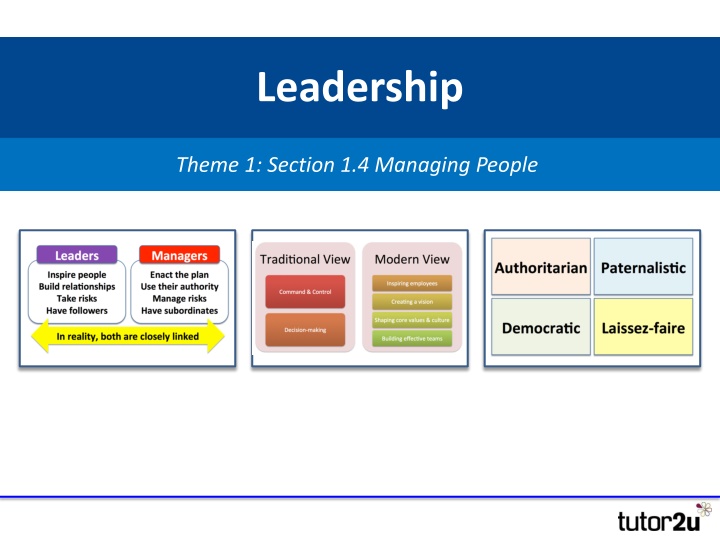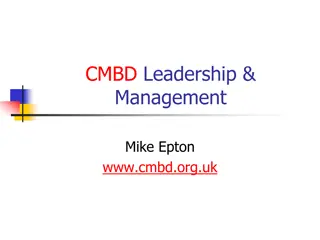Leadership Perspectives and Importance in Business
Different leadership styles, the role of strategic leadership, and why leadership is crucial in today's dynamic business environment. Understand the distinction between leadership and management, types of leadership styles, and how strategic leaders influence corporate strategy.
Download Presentation

Please find below an Image/Link to download the presentation.
The content on the website is provided AS IS for your information and personal use only. It may not be sold, licensed, or shared on other websites without obtaining consent from the author.If you encounter any issues during the download, it is possible that the publisher has removed the file from their server.
You are allowed to download the files provided on this website for personal or commercial use, subject to the condition that they are used lawfully. All files are the property of their respective owners.
The content on the website is provided AS IS for your information and personal use only. It may not be sold, licensed, or shared on other websites without obtaining consent from the author.
E N D
Presentation Transcript
Leadership Theme 1: Section 1.4 Managing People
What you need to know Leadership: The distinction between management and leadership Types of leadership style: Autocratic Paternalistic Democratic Laissez-faire From Entrepreneur to Leader
A General Interpretation of Leadership A relationship through which one person influences the behaviour or actions of other people Source: Mullins (The Nature of Leadership)
Two Different Leadership Perspectives Traditional View Modern View Inspiring employees Command & Control Creating a vision Shaping core values & culture Decision-making Building effective teams
Why Leadership is Increasingly Important in Business Changing organisational structures Flatter + greater delegation Teamwork + focus on quality assurance Coaching, support & empowerment Rapid Change Change is becoming a constant feature of business life Soft skills of leadership & management increasingly important
The Role of Strategic Leadership Strategic leaders are the people who influence or control the corporate strategy of a business Often personally identified with the strategy Occurs both in small firms (e.g. the founder) and large corporates
How Strategic Leadership is Demonstrated Where leaders take direct control Where leaders set the vision and core beliefs Leadership as vision Leadership as command Leadership as decision- making Leadership as symbolic Where the leader weighs up the options and decides Where the leader is the embodiment of the strategy, but not involved day-to-day
Leadership or Management? Leaders Managers Inspire people Build relationships Take risks Have followers Enact the plan Use their authority Manage risks Have subordinates In reality, both are closely linked
The Classic Quote on the Difference Between Leadership and Management Management is doing things right; leadership is doing the right things Peter Drucker
Three Traditional Levels of Management in Business Senior Management E.g. Board of Directors Set corporate objectives & strategic direction Board is responsible to shareholders; led by the CEO Middle Management Accountable to senior management Run business functions and departments Junior Management Supervisory role, accountable to middle management Monitor & control day-to-day tasks, and manage teams of workers
What is a Leadership Style? The way that the functions of leadership are carried out The way that a leader behaves
Traditional Classifications of Leadership Style Authoritarian Paternalistic Democratic Laissez-faire
Authoritarian Focus of power is with the manager Communication is top-down & one-way Formal systems of command & control Use of rewards & penalties Very little delegation McGregor Theory X approach
Paternalistic Leader decides what is best for employees Links with Mayo addressing employee needs Akin to a parent/child relationship Still little delegation A softer form of authoritarian leadership
Democratic Focus of power is more with the group as a whole Leadership functions are shared within the group Employees have greater involvement in decision-making Emphasis on delegation and consultation A trade-off between speed of decision- making and better motivation and morale?
Laissez-faire Leader has little input into day-to-day decision-making Conscious decision to delegate power Managers / employees have freedom to do what they think is best Effective when staff are ready and willing to take on responsibility Not the same as abdication
McGregor Theory X & Y Grouped Managers into Two Types Theory Y Managers Theory X Managers Average worker is lazy and dislikes work Workers need to be controlled & directed Centralised organisation and exercise of authority Most people enjoy work Workers will take responsibility and organised themselves Decision-making can be delegated
Why Modern Business Leadership is Moving Away from Autocratic Styles Changes in society s values Better educated workforce Focus on need for soft HR skills Changing workplace organisation Greater workplace legislation Pressure for greater employee involvement
Factors affecting Leadership Style Type of organisation (size, structure) Effectiveness of teams and groups Skills and experience of subordinates Pressure (time, costs) Personal value systems Manager s experience Confidence in subordinates Feelings of security Nature of the business problems
Which Leadership Style is Best? Many alternative forms & styles Right leader for the right situation Autocratic makes more sense when business is in trouble (e.g. rapid turnaround) Autocratic would be inappropriate where performance highly dependent on effective team-working & decentralised operation Stage of business: start-up v established & complex
Moving from Entrepreneur to Leader Successful entrepreneurs have distinctive characteristics not always suitable for leading a bigger business As a business grows and becomes more complex, delegation is much more important Organisational design and leadership style needs to change as a business matures Many entrepreneurs become ineffective bosses it is often best if they stand aside to let their business develop into the next stage























